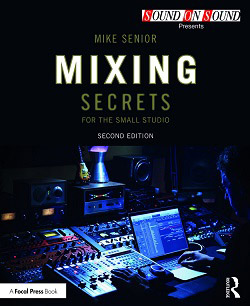Mixing Secrets For The Small Studio - Additional Resources
Chapter 10: Beyond Compression
Table of Contents
Workflow Demonstration Video
If you have trouble downloading or playing this video, here's a mirror file on an alternate server.
Audio Files
(To download all WAV examples at once: 15MB ZIP)
Dedicated Transient Processing: Here are a couple of contrasting real-world kick-drum processing examples which demonstrate the power of transient-driven dynamics processing. The first is a soft-sounding sample Ex10.01: WAV/MP3play_arrow which I heavily processed to increase attack and reduce sustain Ex10.02: WAV/MP3play_arrow for Mix Rescue May 2009. For Mix Rescue April 2009, on the other hand, the original kick-drum sample Ex10.03: WAV/MP3play_arrow was softened and lengthened by reducing the attack and adding sustain Ex10.04: WAV/MP3play_arrow. Notice here that some mild distortion has been introduced as well, by virtue of the transient processing attempting to track some of the low-frequency waveform movements, but in practice this caused me no concerns within the context of this specific mix. One final common application of transient processing is in taking the edge off pick noises on acoustic-guitar recordings. Here’s an example to demonstrate how effective this fix is: this is the unprocessed recording Ex10.05: WAV/MP3play_arrow, and here’s the transient-reduced version Ex10.06: WAV/MP3play_arrow.
Tempo-driven Balancing: Here’s an example from Mix Rescue July 2010 to show how tempo-synchronisation can serve useful mix-balancing purposes: this electric guitar part has lots of recorded-in delay Ex10.07: WAV/MP3play_arrow, but by synchronising U-he’s flexible Uhbik-T

 tremolo plug-in to the project tempo, I can use it to reduce the note sustain between the sixteenth-note picking transients Ex10.08: WAV/MP3play_arrow.
tremolo plug-in to the project tempo, I can use it to reduce the note sustain between the sixteenth-note picking transients Ex10.08: WAV/MP3play_arrow.
Updates
- Update: In the first edition of the book, Figure 10.2 describes Logic’s bundled Envelope Shaper plug-in as a threshold-dependent transient processor. Many thanks to reader Lorenz Reichelt for alerting me that this plug-in can also function in a threshold-independent manner if you set its Threshold control to its lowest possible value.
Links
Affordable Expander/Gate Plug-ins: Most DAW systems have some kind of expander or gate built in, but if not then try some of these: Bob Perry’s freeware Gate

 ; Cockos’s freeware ReaGate
; Cockos’s freeware ReaGate and the several different expander modules lurking within their freeware ReaJS
and the several different expander modules lurking within their freeware ReaJS plug-in; Dead Duck’s freeware Expander
plug-in; Dead Duck’s freeware Expander ; and Xhip’s freeware Gate
; and Xhip’s freeware Gate
 .
.Affordable Threshold-independent Transient Processor Plug-ins: Threshold-independent transient processors are getting more popular, but I find that each one has a slightly different sound, so it’s worth having access to a few options. As far as freeware is concerned, check out Auburn Sounds Couture

 , Black Rooster Audio The Canary
, Black Rooster Audio The Canary
 , Flux BitterSweet
, Flux BitterSweet
 , Sleepy Time DSP Transient
, Sleepy Time DSP Transient , and Sonic Anomaly Transpire
, and Sonic Anomaly Transpire
 . Other reasonably-priced options include SPL Transient Designer
. Other reasonably-priced options include SPL Transient Designer
 , Stillwell Audio Transient Monster
, Stillwell Audio Transient Monster
 , Voxengo TransGainer
, Voxengo TransGainer
 , and Waves TransX
, and Waves TransX
 .
.Affordable Tempo-driven Dynamics Plug-ins: I love the affordable Cableguys VolumeShaper

 and U-he Uhbik-T
and U-he Uhbik-T
 for tempo-driven dynamics effects, but there’s also lots of decent freeware available, such as A1Audio A1TriggerGate
for tempo-driven dynamics effects, but there’s also lots of decent freeware available, such as A1Audio A1TriggerGate
 , AraldFX StormGate1
, AraldFX StormGate1 32‑bit
, Armando Montanez SimpleSide
32‑bit
, Armando Montanez SimpleSide
 , GVST GLFO
, GVST GLFO
 , Melda MTremolo
, Melda MTremolo
 , and TAL Filter 2
, and TAL Filter 2
 .
.Affordable MIDI-driven Dynamics Plug-ins: There are plenty of these around, but my top tip would be Press Play’s freeware EnveLover

 , which is easy to use and super well-specified.
, which is easy to use and super well-specified.
Further Reading
- More Information On Gating: You can read in detail about the theory and practice of gating in these articles: ‘Advanced Gating’ (part 1) and ‘Advanced Gating’ (part 2). The second article also talks about how to use gates to produce tempo-triggered dynamic effects.\

